
An Italian company with a manufacturing heritage stretching back more than 50 years. Initially creating the world first Granita machine and in more recent years extending their expertise from beverage machines into hand built specialist prosumer coffee machines.
Their lead designers latest creation is the ACS Minima it would usually be the first machine a company would create. ACS have constantly surprised me with Innovative and unusual designs but the biggest surprise of all was the challenging set of objectives for the Minima. It was designed to be a high quality performing dual boiler machine for the same sort of money as much cheaper heat exchanger designs. A good trick if you can do it.
As a reviewer and consultant I used to believe the market wanted technical innovation and complexity. With more experience I realised that innovation comes in many forms and it’s not always technical features or software functions. A lot of people just want a machine that is simple to use, but performs well. Increasingly we are in a complex digital world, it’s unavoidable but perhaps why people find “analogue” elements and the simplicity they bring so appealing. There was a long beta program, if you click the link below you can see what changed as a result.
Beta Machines to the production Model, what changed?
Overview and Design Objectives
- No compromise performance requiring a proper quality PID controlled dual boiler system. Excellent performance to make espresso, steam milk and provide hot water.
- Simple to use
- Reliable, simple, easy and cheap to maintain for decades of good service.
- Small as possible, while delivering all design objectives.
- Affordable, the performance of a modern dual boiler machine for the cost of an old fashioned heat Exchanger design.
We have an expression “form follows function” and it’s true that the unusual shape of the Minima is heavily driven by function. Is it beautiful? Yes, to those who value performance and the ultimate value for money. The more you use it, the more it makes complete sense. Lets take each design objective in turn.
No Compromise Performance
To make great espresso and other drinks, you must accurately manage temperature, steam milk and provide hot water, all functional aspects needed for a great performing prosumer machine.
Making Espresso
To make good espresso you need , great fresh coffee, a good grinder and a machine capable of getting the best from the first two. It needs to provide water at the correct stable, adjustable temperature (depending on roast level or type of coffee) and the correct pressure.
Lower quality designs use cheaper methods, none of which are particularly stable or accurate:
- A thermoblock, the cheapest actually use the same thermoblock for coffee brew water and steam, a truly terrible idea.
- Sometimes 2 tiny boilers (300ml) using non PID temperature management (inaccurate, but cheaper). They rely on conduction rather than thermosyphon systems to keep the group warm and groups may take non standard size portafilters and accessories.
The Minima uses the much better and expensive system of quality stainless steel (AISI 316L) boiler for brewing and a separate service boiler for steam/hot water. The video below explains more about the thermoblock system vs the brew boiler used in the Minima (I have shown a non solenoid operated group in the video, the Minima uses a solenoid operated group)..
The Minima is a Dual boiler machine, it separates brewing and steaming using a more sophisticated and very accurate system (a dual loop PID controller) for managing temperature. The brew boiler on the Minima is a perfectly sized 800 ml and controlled by it’s own PID function, importantly it does not share PID parameters with the service boiler.
It uses the beautifully distinctive and quality E61 group head design. Instantly recognisable and ubiquitous in many of the best prosumer dual boiler machines, no expense is spared here. The E61 group allows for a continuous flow of water from the brew boiler to the group and back (the thermosyphon), to keep the group at the correct temperature for making coffee. A double thickness gasket at the back of the group reduces thermal losses to the case.
As a result Minima is able to provide brew water at a user selectable and stable temperature to the coffee, key to making good espresso. If a coffee prefers extraction at 92C or different roast level or blend needs 94C, you precisely select the best temperature for a perfect espresso extraction. Most coffees only extract well in a small range of 91 through to 96C, the PID will make sure your chosen temperature is the temperature you get. The heavy E61 group takes care of any additional temperature stability requirements mechanically due to the sheer mass of metal. It’s an expensive group, but hugely reliable compared to clever and cheaper electronic methods to try and maintain stability using computer cleverness and thermoblocks.
Brew Pressure adjustment is simple accurate and easy with the commercial grade expansion valve. As shown in the video, brew pressure can be adjusted very precisely and over a wide range. The group mounted pressure gauge is easy to read and responsive and the heating elements can be disabled at a push of a button for accurate results unaffected by water expansion.
All this coupled with a gentle and progressive rise to full pressure creates an excellent extraction profile and ideal conditions for espresso preparation. The following videos demonstrate the extraction profile and some typical espresso shots:
Steaming Milk – one of the best (beta machine shown)
Considering the compact size of the Minima, it has one of the largest service boilers in the prosumer PID controlled dual boiler category. A massive 2.3 litres makes it a hugely capable steamer and PID electronic temperature control (far more reliable than older style pressurestats), run as a full power on/off controller maximises performance. The large size means not having to run at extra high pressures (and hence temperatures) to try to achieve some sort of decent steaming performance…very high temperatures are not good for machine electronics..
The steaming is so powerful ACS provide 2 steam tips with the Minima, a large 3 hole for experienced users and a slower smaller 2 hole tip for the less experienced. If you want to steam a half a litre of milk or more, go ahead.
Testing of the 3 hole tip and a steam pressure of just under 1.4 bar (126C) allowed me to steam 180ml of milk for a 6 oz latte in approx 20 seconds and enough milk (500ml) for three x 6oz lattes in around 45s. Steam pressure remains good during steaming a very important factor in producing good micro-foam. The Videos below show the steaming performance of the Beta machine, I didn’t bother making another as it’s unchanged in the production model.
I can state with some confidence that I do not believe there is a machine in the Minima price range that will steam as well as the Minima, not even close. In fact I doubt whether there is any other dual boiler prosumer machine in the 2K price range that will steam as well as the minima can.
I also felt a video of the slower 2 hole tip would be interesting as it’s not much slower, but maintains even more pressure and steam velocity
The steam arm is a fantastic shape and allows the easy use of any size steam jug with the steam wand at any desired angle. The wand gets hot, so you must be careful only to use the grip on the wand. It could have been a cool wall wand for very little extra expense, but it would have limited steaming potential, something that is undesirable. Another reason I like a burn wand is shown in the cleaning tip below.
Hot water
I never advocate using an espresso machine for hot water production, the service boilers are usually quite small at 1.5 litre and are only filled with a litre or less water. Even though the Minima boiler is 2.3 litres and holds over 1.4 litres of water, a kettle usually makes a better job for £25, is faster to heat and descaling a kettle is easy.
If your water is boiler safe and you are strapped for space, you can use Minima as a kettle, the service boiler is certainly large enough. Then the choice becomes, do you keep it on all the time, or heat it when you need it. It’s going to take 5 or 6 minutes to heat the steam boiler from cold. As a test, I bought the service boiler up to 127C and then switched it off. After 65 minutes I returned to the machine, the insulated service boiler had dropped to 100C and took less than 2 minutes to return to 127C.
Simple To Use

Espresso machines become more complicated and manufacturers add new functions every year. 5 years ago I would have welcomed these changes, perhaps even encouraged them. The more knowledgeable I became, the simpler the espresso machines seemed to be and it seemed like a good idea to add more and more functions. I didn’t need to read the manual, I usually wrote the manuals. What seemed simple (to me) and what I thought were a great set of new functions confused a lot of people. We all have busy lives, it’s a complex world out there and sometimes we just things to be simple. Years ago I used a machine where just turning off the service boiler needed multiple presses of a controller to access the function in a menu. I thought “why oh why isn’t there just a switch for the service (steam) boiler”!
A lot of people want to lift a cover, fill the tank with water and flip a switch to make espresso….that’s it. Perhaps they will use a set of scales to weigh the coffee in and the espresso out, but they don’t want to get more complicated than that. If they want the steam boiler on or off, they simply want to flip another switch. If they want the machine on a timer, they want to be able to plug it into any timer they like. Believe it or not some machines have some complicated electronic on/off circuitry that won’t allow the use of a smart plug or simple time switch because the machine is like a TV and powers on in standby. Some machines have power save options you didn’t ask for and often you can’t even disable, not great on a prosumer espresso machine. Imagine coming back to a machine too cool to make coffee after 30 minutes (yes there is a machine that does this, more than one in fact). The Minima comes on when you switch it on and goes off when you switch it off, you are in control.
I have mine on a Meross WiFi plug and have it set to accept voice on/off commands from Alexa and a saved power scheme that switches it on a 9:00 am and off at 11:59 pm every day.
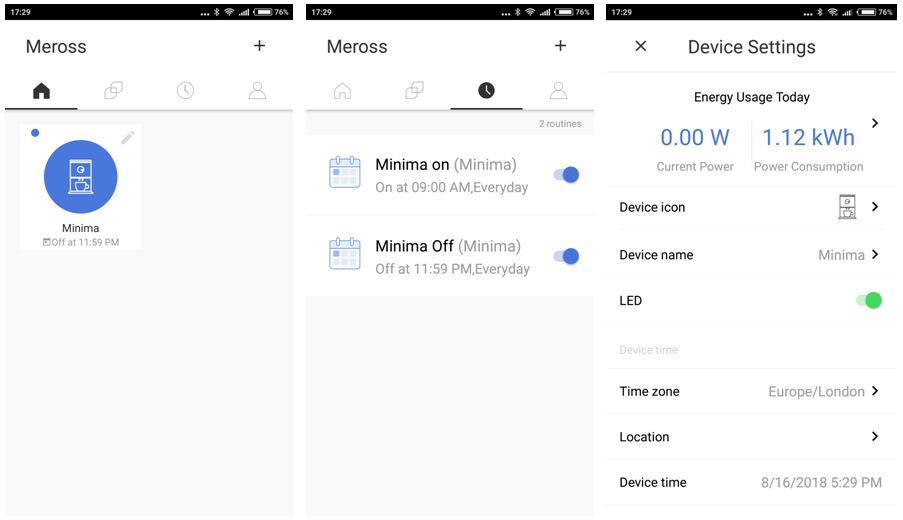
The Minima has one advanced menu that you may never need to access, your retailer will probably have set it up for you. If you do have to access it, it’s a 5 minute job, “set and forget”, you should never have to repeat it again.
Other than that it has:
- An on/off switch to make espresso (up to pull a shot, down to stop)
- Another 3 way switch, off, brew and brew+steam
- A PID display that acts as a shot timer, tells you the water tank needs filling and allows you to change brew or service boiler temperature with a couple of button presses.
- It has another feature that is automatic, you never have to worry about. It’s called Last Shot Protection (LSP). It will always complete that last shot.
That’s it….the user manual will be pretty short, Minima harks back to a simpler time, the good old days, without the bad old components and design. Simple and easy to use but with great performance. Of course if you like complexity and functions, the Minima may not be for you.
Full Last Shot Protection (LSP)
It’s something I came up with years ago. It always annoyed me when most espresso machines run low on water in the internal tank, they simply stopped right in the middle of the shot…often one of the better shots as well. The coffee was wasted, the espresso undrinkable. It’s not like you can fill the water tank and have the shot continue, believe me that doesn’t work. Existing owners of prosumer machines will know exactly what I mean.
The other shot failure mode is when the service boiler autofills, this drops the pressure at the group and ruins any ongoing shot.
The Minima has the same comprehensive LSP as it’s more expensive cousine the Vesuvius and prevents both problems. The shot continues until you end the shot, only then will the machine say H2O and disable the pump so no further shots are possible until you fill the tank. A shot is never wasted just because of low water in the internal water tank or a service boiler autofill. Best of all you don’t have to worry about it, it works in the background covering your back.
Accessories
The ACS Minima comes with a decent enough accessory pack and facilitates easy customisation with your own preferred accessories should you wish to do this. Everyone is different so a 1 size fits all approach doesn’t work when it comes to tampers, custom knobs and handles etc.. The accessories have been chosen to make customisation as easy as possible (the handles are not threadlocked to the portafilters), provide everything you really need and keep unnecessary costs down..
ACS have settled on the items below, but as always this may be subject to change:
- Country specific mains cable
- 2 portafilters, double and single
- Double basket, single basket and blind filter (rubber disk)
- 1 spare group gasket
- 4 felt pads and 4 rubber pads for the feet
- Group cleaning brush
- Raised Cup stand (for espresso cups)
- Plastic Tamper
- User Guide
Optional Accessories (work in progress)
ACS are deciding on an optional accessories pack, this is subject to change and there is no pricing yet. I personally think it needs a bit more thought, as two of the key items for many will be the bottomless portafilter and 2 hole steam tip. The tamper is nice, but many people will already have one.
- Metal (Aluminium) ACS branded Tamper
- Metal Blind filter
- Naked or Bottomless portafilter
- 2 hole steam tip
- Steam wand clip

With complexity comes more difficult fault finding, more to go wrong, more expensive to fix. The Minima is compact, this means a few challenges getting to some components, but nothing too difficult. It’s not over complex and where possible mechanical solutions have been used to solve problems as they usually give less trouble than complex electronics. In other areas unusual solutions have been chosen in the interest of reliability, longevity or serviceability. Things that were easy in manufacture, but not right have been eliminated. Components were chosen to give the right performance but having simplicity, easy availability and reliability. Questions were asked at every stage about the costs of spare parts to keep those as low as possible. Bespoke parts are unavoidable in espresso machines but the number of bespoke components have been kept to the minimum.
Stainless Steel (AISI 316L) boilers
They are insulated,very high quality , 2mm thick with 8mm thick end plates. Sealed units with long life Incoloy 800 heating elements welded in minimise the chance of leaks compared to screw in elements and a gasket. The factory build is simpler, with less concern about leaks and no service hatch required in base plate.
Leaking around the gasket of screw in elements (or bolted flanged elements) is quite common and I hear of many machines having problems after 3 – 7 years, or even when brand new. The screw in elements are usually very difficult to remove without specialist equipment (impact wrench) and a suitably sized, but expensive socket. Removing screw in heating elements elements without damage almost always requires requires boiler removal
The Incoloy 800 elements are expected to last the reasonable service life of the machine (decades) but if an element fails, the entire boiler is replaced. The cost of which will not be significantly more than a conventional copper heating element and take no longer
I dislike embedded elements in cheap thin steel boilers, but I don’t mind high quality long life Incoloy 800 elements in a great quality boiler that is at least 35% thicker than in many dual boiler machines costing almost £600 to £1000 more. It makes the boiler more compact, it’s easier to build with less problems and allows for a smaller machine.
During development I strongly suggested standard recommended pricing for the boilers to prevent them being a retail high profit item. At the time of writing (2019) ACS have agreed the following standard pricing and if you have trouble obtaining one from your local retailer at these prices, ACS will sell you one at the standard RRP.
- Brew boiler 80 euro inc VAT + P&P
- Service boiler 100 euro inc VAT. + P&P
A little more than a screw in copper heating element and the same or less than an Incoloy 800 element. ACS know this unusual step may upset retailers but it’s not seen as a high failure item
Component placement
thought has been given to component placement and electronics are in the coolest areas of the case. The PID you can see, although high up, is actually only a display, it’s electronics are in the cooler base of the machine under the boilers connected via a long ribbon cable.
I did take temperature measurements inside the case of the machine and the results were:
- 3cm into the top of the case in between the boilers 60C
- 1cm above the service boiler 70C when on
- 1 cm above the brew boiler 55C (65C if service boiler on)
- below the brew boiler near all the electronics 40C or less
Vibration pump
Minima has a vibration pump has been carefully chosen to deliver an appropriate rate of flow, whilst being as quiet as possible. Vibration pumps do make a distinctive noise, but placement and machine design have reduced the noise and eliminated any rattles that are all too common on some vibration pump machines.
The vibration pump has a number of advantages over their much quieter rotary pump cousins:
If you can accept the noise of a vibration pump, then other complications become unnecessary, it’s generally more reliable and maintenance is simpler.
Solenoid E61 group
These are in interesting choice and not very common nowadays on E61 prosumer machines because many prosumer machines have a rotary pump, which requires a mechanical pre-infusion chamber, not part of a solenoid group. With vibration pump machines, if the system is carefully selected and the Gicleur (pin hole) in the E61 group is the right size…no preinfusion chamber is required. This has a lot of advantages (saving money is not one of them):

Non solenoid fully mechanical E61 groups (shown above) have a little lever you move which manually actuates, cams and valves with springs. This type of group has some disadvantages when compared to well specified solenoid operated E61 groups on vibration pump machines.
E61 Lever (mechanical) group
- A fully mechanical E61 group requires lever and cam removal for lubrication after backflushing with cleaner (or descaling). If these parts are not removed each time and lubricated with a product like Dow Corning Molycote 111 (food safe), excessive wear will result.
- There are various wear items on a mechanical group that require replacement at different times, lever spindle seals, valves, springs and the cam. Rebuilding ideally needs parts from the actual group manufacturer for that perfect fit and feel.
- There is a higher volume of water in the group during and after the shot, making cleaning more difficult
- As parts wear the incidence of gradual leaks affecting brew boiler levels is greater than with a solenoid group.
Solenoid group
- The solenoid E61 group valve requires no lubrication after backflushing with cleaner and no special maintenance is required. It can be stripped for cleaning if ever required.
- There are far less moving parts to clean and no preinfusion chamber to get dirty, basically a cleaner internal group
- Less water volume required (12% for a double and 6% for a single) as no preinfusion chamber to fill
- replacement of the solenoid valve if needed, is quick, easy and cheap…they are inexpensive standard parts available off the shelf (unlike lever E61 group parts)
- It leaves more working space on the drip tray with no lever in the way
- It can potentially last longer than the components in a lever E61 group, which are subject to wear.
- No group valves and seals to leak, a lever E61 has a top valve, preinfusion valve and vent valve, plus 3 springs and a rotating cam. These mechanical valve actuations can cause problems if certain error conditions occur and certain specific actions are not taken.
A solenoid group was chosen purely for technical and performance reasons, not cost savings. It’s a slight hassle and extra expense for the manufacturer to make a small and attractive shroud to cover the solenoid portion of the group, a little extra wiring and some case work. The groups themselves fully kitted cost a similar amount, but ACS paid more to have customised groups with straight drilled holes prior to chroming for the pressure gauge.
Group Mounted pressure gauge
In the beta machine a dual gauge was in the case on the right hand angled side at the bottom. I disliked this because they get dirty, can be subject to installation issues during assembly, can leak, or the needle flutter due to pulses from the Vibration pump or expansion valve. Fitting a maintenance replacement would not have been easy. If you read around you will often see false pressure, fluttering gauges or broken gauges mentioned.
Mounting the gauge on the group allows direct accurate pressure measurement close to the coffee puck, has no flutter and no internal pipework for leaks, especially as it now measure brew pressure only (the PID shows the service boiler temperature). The reason it wasn’t always group mounted was because ACS needed to the E61 solenoid group properly customised (at my request) to allow a straight mounted gauge. It is technically easier for the manufacturers to drill certain holes at an angle compared to a mechanical E61 group and the gauge mounts in one of the standard holes in the group (usually drilled at an angle). This cost ACS a little extra, but it’s well worth the effort. If this gauge ever fails, replacement will take about 2 minutes with no tools required. Is it the best place to mount a gauge on an E61 machine?…Yes, technically I believe it is.

Small as possible, while delivering all design objectives
I don’t think any machine with boilers the size of the Minima could be made smaller and still be practical in use. There are two types of machine as mentioned earlier, the compact simple HX machines with a single boiler, a compromise on performance to keep down to a price. Or compact dual boiler machines.
Even the most compact HX machine is just under 20% narrower, most are the same size or larger than the Minima. There is no E61 prosumer dual boiler machine I know of as small as the Minima and certainly none have service boilers as large as the Minima

Minima measures 270mm x 370 mm x 440mm (WxHxD). The cup warmer tray base is at a height of 350mm.
It has a usable drip tray area of 313 sq cm, this is very large for such a compact machine. The unusual shape of the machine allows for easy placement of various accessories on the drip tray, whilst still being able to use the machine.It was important a compact size did not limit performance in any way and all the required minimum functions of a dual boiler should be available. My personal view is; simple is good only if it’s good enough! I believe the designer succeeded….
Very affordable, the performance of a modern dual boiler machine for the cost of an old fashioned heat Exchanger design
As we all should know, you don’t get something for nothing. Good marketing may make it seem as if you can, but we all know deep down, you pay for what you get. Fortunately clever and appropriate design doesn’t cost anything but neurones.
Minima has everything you need to make great coffee, but without the price tag. In a sense, the Minima is unique in what you don’t get, no fancy marketing, features, functions or bespoke bits of “art”. These things add to the cost of an espresso machine and hence the price you pay. They rarely add to the performance.
The Minima design story is a little unusual. It started with “create a dual boiler, a target price to meet, if, and only if, it didn’t compromise performance. The performance had to be at least as good as other dual boiler machines and if possible better in some areas (steaming).
Conclusion
The Minima is a hand built Italian machine with a hugely challenging objective. Creating a dual boiler machine with excellent performance, for the price of a standard single boiler prosumer grade HX machine is challenging. I believe they and it delivers a fantastic level of performance for the price.
Many manufacturers have got a little complacent and produce machines that are “shiny”, but cheap inside. Or they charge a lot of money for what are single HX machines where the design is from the 60s. We need to move on from this type of machine, but for many people the extra cost of a dual boiler makes them unattainable. In the general scheme of things a Minima is a significant sum of money, but cheap compared to other prosumer dual boilers and less expensive than many machines that are dual boilers, but not at the prosumer level. By this I mean, painted cases, mild steel painted frames, plastic construction, small boilers or small boilers and a thermoblock.
I hope it actually changes the market a little, I’d like other manufacturers to sit up and take notice, be a little more innovative and stop pushing the older tech because it’s easy, cheap and very profitable. Perhaps we will see more machines like the Minima with a real focus on performance and value.
Should you buy one
I think it’s important to understand what makes YOU happy about a purchase and what pushes your buttons about ownership. Although the Minima makes espresso as good as the best of the prosumer dual boiler machines, will probably steam better, be less maintenance hungry with the solenoid group and cost significantly less….for some people that won’t be enough. For others it’s simplicity, ease of use, no compromise performance and great value will have been exactly what they have been looking and waiting for.
It has certainly earned a place in my heart as a plucky little machine that’s full of Italian spirit…
So it’s not a work of art, full of functions an “ultra premium” product. It’s a “sleeper”, works just as well to make espresso and when you start steaming…..the competitions eyes widen. When you pull a shot if they ask what you paid and you answer, there is silence except for the noise of the vibe pump in the background….but as you sip your espresso, it doesn’t seem to matter any more!
Specifications
| Height – Width – Depth: | 370 x 270 x 440 mm |
| Weight: | 18 kg approx |
| Voltage & Power: | 230 V-50Hz, 2200W (when used in simultaneous heating mode), 1200W in brew boiler priority mode or steam boiler priority mode. |
| Water Tank : | 2.6 litres, removable with low water sensor. 2.3 litre usable (approx) |
| Boilers: | Twin insulated boilers, service boiler 2.3l (steam and hot water), 1200W , Brew boiler 800ml 1000W AISI 316L Stainless Steel (surgical grade) 8mm end plates, 2mm thick walls |
| Pump Pressure: | 15 bar max – adjustable, recommended 9 bar. |
| Group Head: | E61 solenoid group (58mm), standard size |
| Supplied Accessories | Country specific mains cable 2 portafilter handles Double and Single portafilter body Double basket, single basket and blind filter (rubber disk) 1 spare group gasket 4 felt pads and 4 rubber pads for the feet Group cleaning brush Plastic Tamper Raised Cup stand (for espresso cups) User Guide |
| Construction: | All Stainless Steel frame, body and boilers (all 2 mm thick), removable drip tray, cup warmer. Metal feet (height adjustable) |
| Water/Steam | Hot water on demand. Steam on demand, wands on ball joint mounts. Steam Boiler can be switched On/Off as required |
| Pressure Gauge | Group mounted |
| UK Retailer Warranty, Spares and service | Bella Barista – https://www.bellabarista.co.uk/ |



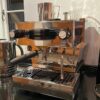
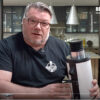
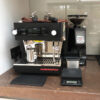

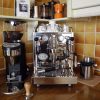
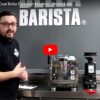
Join the discussion One Comment